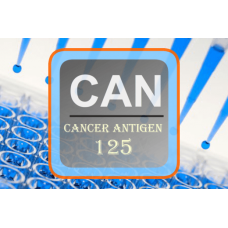Shopping Cart
0 item(s) - $0.00Cancer Antigen ELISA - CA 125
Availability: In Stock
Add to Compare
Enzyme Immunoassay for the Quantitative Determination of CA 125 in Serum.
FOR RESEARCH USE ONLY. NOT FOR USE IN DIAGNOSTIC PROCEDURES
SUMMARY
CA-125 (cancer antigen 125, carcinoma antigen 125, or carbohydrate antigen 125) also known as mucin 16 or MUC16 is a protein that in humans is encoded by the MUC16 gene. MUC16 is a member of the mucin family glycoproteins. CA-125 has found application as a tumor marker or biomarker that may be elevated in the blood of some patients with specific types of cancers, or other benign conditions.
CA-125 is the most frequently used biomarker for ovarian cancer detection. Medical societies including American Congress of Obstetricians and Gynecologists recommend against women with average risk of ovarian cancer having routine CA-125 screening or other screening for this cancer. Reasons for this include evidence ambiguous test results are more likely to lead to further invasive, harmful, and unnecessary health care than they are to detect ovarian cancer in women who are at average risk of developing it.
Around 90% of women with advanced ovarian cancer have elevated levels of CA-125 in their blood serum, making CA-125 a useful tool for detecting ovarian cancer after the onset of symptoms. Monitoring CA-125 blood serum levels is also useful for determining how ovarian cancer is responding to treatment (with the duration of disease-free survival correlating with the rate of fall of CA-125) and for predicting a patients prognosis after treatment. This is because the persistence of high levels of CA-125 during therapy is associated with poor survival rates in patients. Also, an increase in CA-125 levels within individuals in a remission is a strong predictor of the recurrence of ovarian cancer. Indeed, a rising CA-125 level may precede clinical evidence of disease relapse by an interval of 3 to 6 months.
Prognosis relates to both the initial and post-treatment CA-125 values. A preoperative value >65 U/mL suggests a poor prognosis. Persistent elevations following chemotherapy indicate a poor prognosis. The half-life of CA-125 after chemotherapy correlates with prognosis (patients with CA-125 half-life <20 days show improved survival). Time-to-normalization (rate of fall of CA-125) affects prognosis with more rapid normalization within 3 cycles of chemotherapy correlating with improved survival.
PRINCIPLE OF THE TEST
The CA125 ELISA test is based on the principle of a solid phase enzyme-linked immunosorbent assay. The assay system utilizes a monoclonal antibody directed against a distinct antigenic determinant on the intact CA125 molecule is used for solid phase immobilization (on the microtiter wells). A rabbit anti-CA125 antibody conjugated to horseradish peroxidase (HRP) is in the antibody-enzyme conjugate solution. The test sample is allowed to react simultaneously with the two antibodies, resulting in the CA125 molecules being sandwiched between the solid phase and enzyme-linked antibodies. After incubation at 37C for 90 minutes, the wells are washed with Wash Buffer to remove unbound-labeled antibodies. A solution of TMB Reagent is added and incubated for 20 minutes, resulting in the development of a blue color. The color development is stopped with the addition of Stop Solution changing the color to yellow. The concentration of CA125 is directly proportional to the color intensity of the test sample. Absorbance is measured spectrophotometrically at 450 nm.
EXAMPLE OF STANDARD CURVE
Results of a typical standard run with optical density readings at 450 nm shown in the Y axis against Cancer Antigen concentrations shown in the X axis. This standard curve is for the purpose of illustration only, and should not be used to calculate unknowns. Each user should obtain his or her own data and standard curve.

| General | |
| ANALYTE GROUP | Cancer Antigen |
| GROUPING | Cancer |
| PRODUCT NAME | ELISA |
| STORAGE | Store the kit at 2-8°C |
| COUNTRY OF ORIGIN | USA |
| DISCOUNTS | Bulk Packaging; High Volume |
| ELISA | |
| TESTS PER KIT | 96 (12 x 8) |
| CALIBRATION RANGE | 0 - 400 U/mL (Recommended) |
United Immunoassay, Inc. © 2025


































